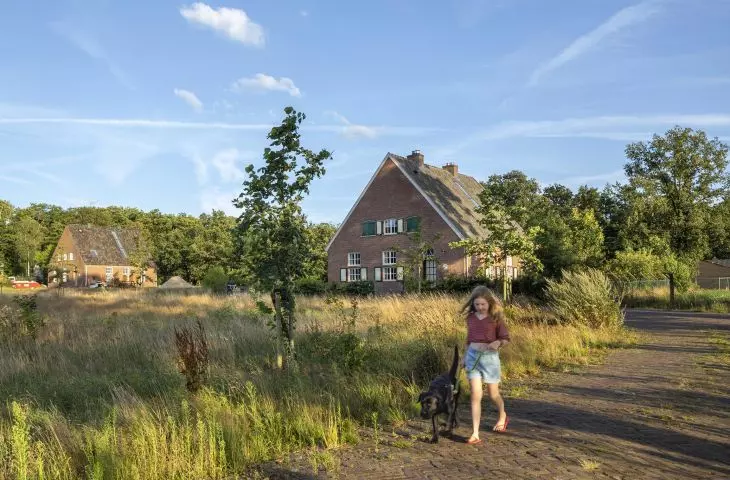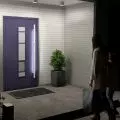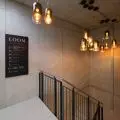Buitenplaats Koningsweg,
design: MVRDV Studio
{Studio}, landscape studio Buro Harro and developer KondorWessels Projecten have completed the Buitenplaats Koningsweg project, transforming a former World War II German military base into a residential and cultural complex set in one of the most valuable natural landscapes in the Netherlands. Working within the framework of this plan on the outskirts of Arnhem, MVRDV and KondorWessels Projecten have also completed three sustainable residential buildings, offering a total of 21 homes. Located in the Veluwe forest, the project brings a piece of Dutch history back to life.
The picturesque surroundings of the revitalized buildings on Buitenplaats Koningsweg
Photo: Daria Scagliola © MCRDV
Revitalized bunkers in the Veluwe woods
Buitenplaats Koningsweg began its existence as two facilities - Kamp Koningsweg Noord and Zeven Provinciën. They were built near Deelen Airport, which was the largest German airfield in the Netherlands during World War II. The concrete military bunkers, to hide their military purpose, were camouflaged farms, allowing them to blend in with the surrounding nature. The project is located in the Veluwe forest, one of the most important natural areas in the Netherlands and the country's largest land-based Natura 2000 site.
Aerial view of Buitenplaats Koningsweg surrounded by the Veluwe forest
Photo: Jannes Linders © MCRDV
Preserving the architectural heritage of the 20th century in the Netherlands
Before the buildings were listed as Dutch national monuments in the second half of the 20th century, numerous changes were made to them. MVRDV and Buro Harro took this history into account in the development plan: according to the rules of the heritage registry, existing, mostly brick buildings are preserved (in the case of original German structures) or transformed (in the case of later Dutch structures), and changes such as new doors and roof windows are clearly distinguished by dark gray finishes. Meanwhile, previously demolished buildings were rebuilt in the same shapes and sizes, but using light gray materials.
A bird's-eye view of a house hidden among greenery with solar panels on the roof
Photo: Jannes Linders © MCRDV
clear reinterpretation of history
An unusual aspect of Buitenplaats Koningsweg is that the buildings were designed from the beginning to hide their true nature. How could contemporary efforts help highlight their history while maintaining integrity with the original design? Our answer was to make the changes clearly visible. The contrast between the old, new and rebuilt elements, as well as details such as the meter-high bunker walls, help intuitively understand the history of the site.
- Says Nathalie de Vries, co-founder of MVRDV.
A house in the woods with a marked bike path surrounded by greenery and trees
Photo credit: Daria Scagliola © MCRDV
From concrete desert to harmonious landscape
The landscape design keeps hard surfaces to a minimum, and narrow paths allow nature to flourish between buildings. Fences that previously surrounded the site have been removed to allow wildlife to move freely.
The landscape of the Veluwe has been stretched over the site like a blanket, just as barracks and an airfield were once masked to blend in perfectly with their surroundings. When we started, the area was deserted, heavily paved and built up. Now people live, work and relax in a peaceful landscape that feels like it has always been here.
-says Harro de Jong of Buro Harro, one of the initiators of the Buitenplaats Koningsweg project.
Two renovated residential buildings, combining modernity with traditional 20th-century architectural style
Photo: Daria Scagliola © MCRDV
blurring the boundaries between nature and architecture
Thanks to the restoration, the boundary between the Buitenplaats Koningsweg buildings and the Veluwe forests is fading - a change that will soon be formalized as the Buitenplaats Koningsweg public spaces will be officially handed over to the city of Arnhem.
Two newly renovated buildings surrounded by a forest with a terrace ideal for spending time outdoors
Photo credit: Daria Scagliola © MCRDV
Navigating the complex history of the site was not without its challenges. We needed both creativity and perseverance to make the vision a reality. But the end result makes it well worth the effort. We have created something truly unique - an opportunity to live, work and relax in nature, with small private gardens and common spaces. This is something that sets this project apart from many other estates in the Netherlands.
-Says Arnold Sprakel, developer at KondorWessels Projecten.
A gray house in the forest with many windows, a dark roof and solar panels, surrounded by tall trees and a garden
Photo: Daria Scagliola © MCRDV
camouflage in architecture: a modern estate in a forested space
The plan calls for 11 buildings in the northern part of the site for vacation rentals, which blend harmoniously into the surrounding forest through creative use of the camouflage motif. They were selected as part of a design competition organized by KondorWessels Projecten and Buro Harro.
A restored red brick house with a dark roof and modern architectural elements, surrounded by field flowers
Photo: Daria Scagliola © MCRDV
The latest phase of the 16-year transformation includes three nearly identical residential buildings designed by MVRDV, each consisting of seven row houses. According to the master plan , the structures have the same location, shape and size of buildings as those that once existed here. The gray slate walls and roofs indicate that they are reconstructions.
A restored red brick building with modern celadon accents and a wall overgrown with ivy, surrounded by wildflowers
Photo credit: Daria Scagliola © MCRDV
Future owners of these "terraced houses in the woods" will be able to choose their favorite room layout from several options. The houses are located at an elevation above ground level, with outdoor spaces that are only minimally sheltered. Aside from small terraces, they have no gardens, but instead offer close contact with the surrounding woods. Between the houses there are large common spaces both in front and behind the buildings.
The stylish interior of a modern house with a terrace, ideal for relaxation and gatherings
Photo: Daria Scagliola © MCRDV
eco-friendly construction solutions: wood and recycling
Special attention has been paid to sustainability in the design of these buildings. The walls and roofs are made of wooden frames, and some of the gravel in the concrete mix has been replaced with recycled material. Floating terraces are constructed of recycled plastic. Thanks to solar panels and high insulation values, the 15 houses in the middle of each block achieve energy neutrality in use, while the six houses at the ends are close to achieving this goal. Parking spaces have been provided under each building, which have been designed to accommodate future electric car charging and bicycle parking. This is intended to encourage residents to make more sustainable transportation choices.
Camouflaged among an overgrown garden, the apartment building and two people sitting among the vegetation
Photo credit: Daria Scagliola © MCRDV
Elaborated: Natalia Ledzianowska
Illustrations provided courtesy of the MVRDV studio.


















































































